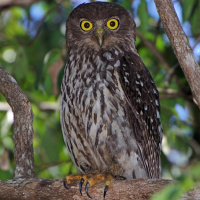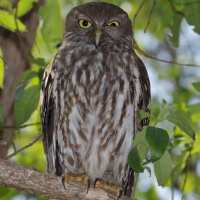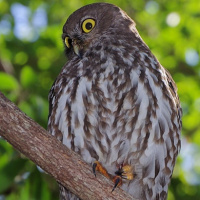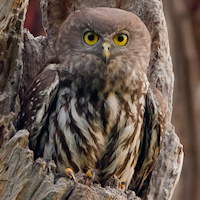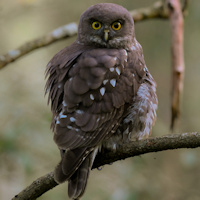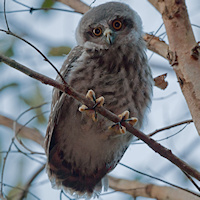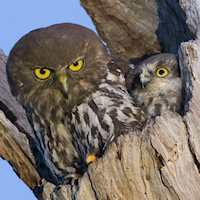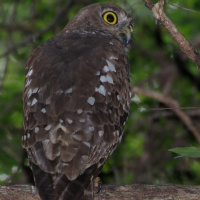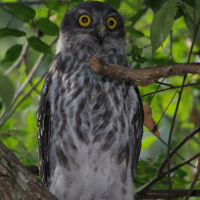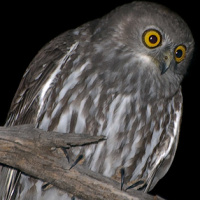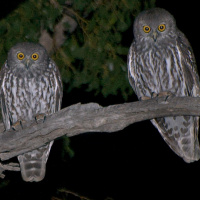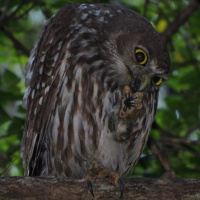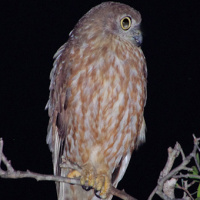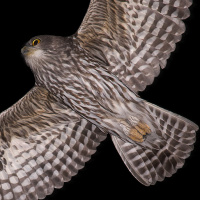Introduction
The Barking Owl is a medium-sized, robust owl with a rounded head and no ear-tufts. It is named for its remarkably dog-like barking call. It is also known as the Winking Owl.
Photo Gallery (16 pictures)
Sound Gallery
Information
Description: The forehead, crown and facial disc is greyish-brown, with the facial disc having an indistinct rim. Eyes are yellow, the cere
is greyish, and the bill is greyish-horn to blackish. The back and mantle are smoky greyish-brown and rather uniform. The scapulars have large whitish areas on
the outer webs, forming a whitish row across the shoulder. Wing-coverts are smoky grey-brown with small whitish spots. The primaries and secondaries are slight
darker than the wing-coverts, and are barred with very narrow whitish bars. The tail feathers are grey-brown with 5-6 narrow whitish bars.
The throat is whitish-buff, and streaked greyish-brown. Throat feathers are erectile giving a bearded appearance.
Underparts are creamy-buff to whitish, with prominent greyish-brown streaks. There is considerable individual variation here, with streaks varying from narrow
to broad, and from darker to paler.
Tarsi are feathered. The toes are sparsely bristled, and coloured dull yellow or yellowish-brown. Claws are horn, becoming dusky towards the blackish tips.
Size: Length 35-45cm. Wing length 244-325mm. Tail length 143-198mm. Weight 425-510g, however, other studies conducted in the Pilliga Forest in New South Wales have adult weights from 645 to 960g. On average, the male of any pair was 8% heavier than the female.
Habits: Generally nocturnal, but sometimes calls during the day, and on duller winter days may begin hunting before sunset. Barking Owls are usually found in pairs, and characteristically roost in isolated stands of trees in open country, often faithful to same spot for months or years. They are attracted to water and may bathe regularly early in the morning.
Voice: Extremely characteristic, loud and remarkably dog-like double bark, 'wuf wuf' or 'wuk wuk'. Barks are always preceded by a short, low groan but this is audible only at close quarters. Calls are usually given at dusk and dawn, often in yapping choruses between male and female which may go on for several minutes. They do not call for long periods through the night like the Boobook. The female's call is noticeably sharper and shorter than the male's and carries further. Females sometimes use a low, groaning hoot of almost cow-like quality to call to young. A dog-like snarling is used in aggression by both sexes near the nest. Barking Owls are also notorious for their "screaming woman" call - it is described as a scream of terrifying intensity which sounds remarkably lifelike. This is not a common call and more likely to be used outside the breeding season. Its significance is unknown.
Hunting & Food: Barking Owls are agile and aggressive hunters, taking a wide range of prey. They hunt earlier in the evening and later in the morning than any other Australian Owl, taking many types of birds, including House Sparrow, Magpie Lark, small pigeons, Blue-faced Honeyeater, Laughing and Blue-winged Kookaburra, Red-rumped Parrot, Tawny Frogmouth, Australian Magpie, White- winged Chough, White Cockatoo and several species of duck. In southern Australia the Rabbit is now the main prey, but gliders, small possums, bats and rodents are also taken. Like other Ninox Owls they take many insects, particularly outside the breeding season, beetles and crickets being most common. Most prey appears to be taken on the ground or when perched.
Breeding: A late winter breeder with most eggs laid July to September. Cape York and Arnhem Land birds may be a little earlier but there seems to be no time difference between north Queensland and Victoria. Pairs perch close together at the start of the season with bouts of animated calling. The male appears to choose the nest site but rarely visits after laying. The nest is a large hollow up to 30 metres high, in the trunk or large limb of a tree. They will occasionally nest in deep forks of trees, rock crevices and rabbit burrows. The same site is often used for many years. The female occupies the hollow immediately before laying 2 or 3, occasionally 1, white, dull, almost spherical eggs 43-50mm x 36-41mm. They are laid at 2-3 day intervals and incubated by the female alone for approximately 36 days. The young have first and second downs of white and are fledged in about 35 days. All Ninox Owls leave the nest while still partly downy, but fledgling Barking Owls are downiest of all. Young roost near and remain with parents for several months.
Habitat: Ideal habitat is open country with a choice of large trees for roosting and nesting. In southern districts, Barking Owls choose creeks and rivers, particularly with River Red Gums, isolated stands of trees and open woodland. In northern Australia they favour paperbark swamps as well as previous habitats. Although they are generally wary at their nest, they may become very accustomed to humans, nesting close to farm buildings and even in streets in towns. They have a distinct preference to be close to water.
Distribution: Coastal and subcoastal districts almost right around Australia. Distribution is very uneven and broken. Absent from much of central Australia and the Nullarbor Plain. Also absent from Tasmania and the large offshore islands. Barking Owls are also found in New Guinea and the Moluccas.
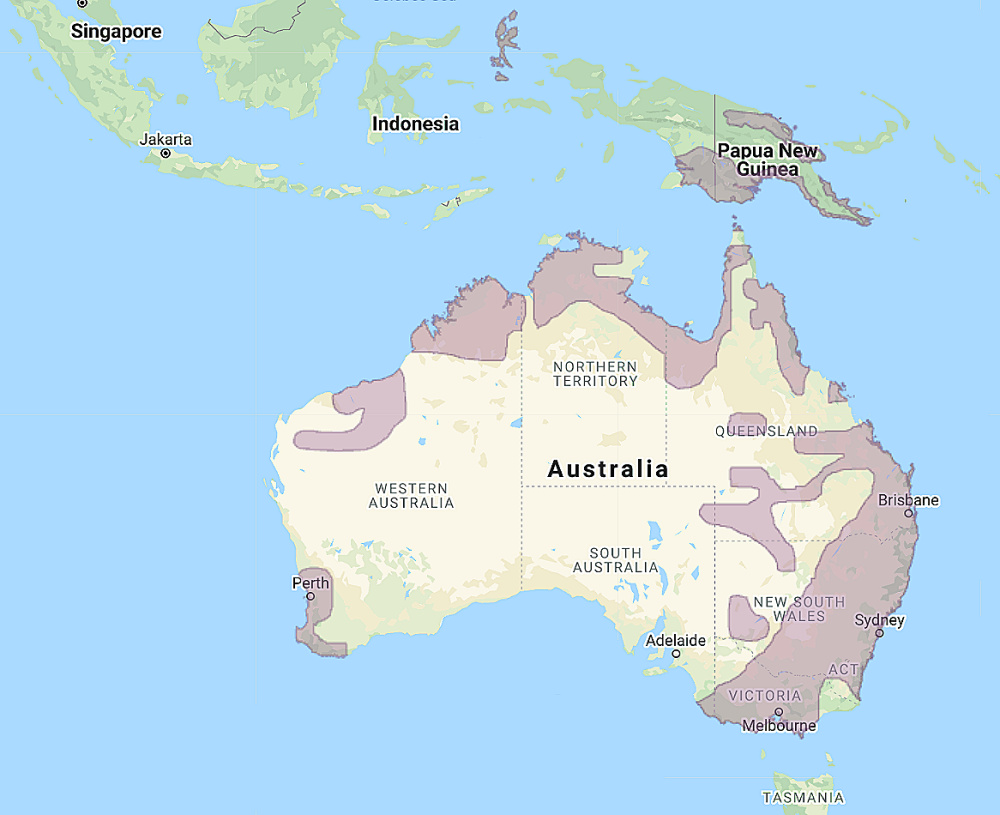
Range of the Barking Owl Ninox connivens
Status: Generally not common. Listed as 'Least Concern' by Birdlife International.
Original Description: Latham, John. 1802. Supplementum indicis ornithologici sive systematis ornithologiae, p. xii.

